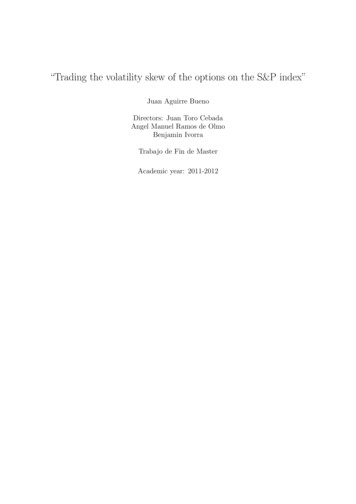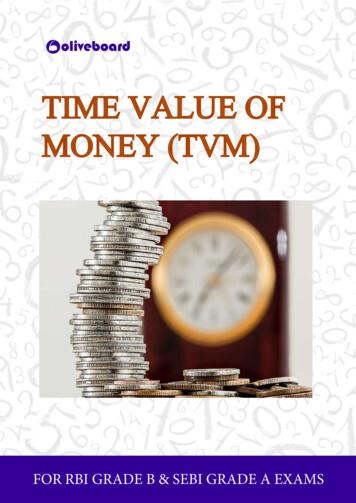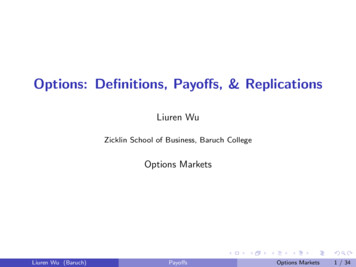
Transcription
FIN 301Class NotesChapter 4: Time Value of MoneyThe concept of Time Value of Money:An amount of money received today is worth more than the same dollarvalue received a year from now. Why?Do you prefer a 100 today or a 100 one year from now? why?- Consumption forgone has value- Investment lost has opportunity cost- Inflation may increase and purchasing power decreaseNow,Do you prefer a 100 today or 110 one year from now? Why?You will ask yourself one question:- Do I have any thing better to do with that 100 than lending it for 10extra?- What if I take 100 now and invest it, would I make more or less than 110 in one year?Note:Two elements are important in valuation of cash flows:- What interest rate (opportunity rate, discount rate, required rate ofreturn) do you want to evaluate the cash flow based on?- At what time do these the cash flows occur and at what time do you needto evaluate them?1
Time Lines: Show the timing of cash flows. Tick marks occur at the end of periods, so Time 0 is today; Time 1 is theend of the first period (year, month, etc.) or the beginning of the secondperiod.0123CF1CF2CF3i%CF0Example 1 : 100 lump sum due in 2 years012i100TodayEnd ofPeriod 1(1 periodform now)End ofPeriod 2(2 periodsform now)Example 2 : 10 repeated at the end of next three years (ordinary annuity )0123101010i2
Calculations of the value of money problems:The value of money problems may be solved using1- Formulas.2- Interest Factor Tables. (see p.684)3- Financial Calculators (Basic keys: N, I/Y, PV, PMT, FV).I use BAII Plus calculator4- Spreadsheet Software (Basic functions: PV, FV, PMT, NPER,RATE).I use Microsoft Excel.3
FUTUR VALUE OF A SINGLE CASH FLOWExamples: You deposited 1000 today in a saving account at BancFirst that paysyou 3% interest per year. How much money you will get at the end of thefirst year ?i 3%FV101 1000 You lend your friend 500 at 5% interest provided that she pays youback the 500 dollars plus interest after 2 years. How much she shouldpay you?i 5%0FV212 500 You borrowed 10,000 from a bank and you agree to pay off the loan after5 years from now and during that period you pay 13% interest on loan. 10,000012345FV5i 13%InvestmentPresentValue ofMoneyCompounding4FutureValue ofMoney
Detailed calculation:Simple example:Invest 100 now at 5%. How much will you have after a year?FV1 PV INT PV (PV i) PV (1 i)FV1 100 INT 100 ( 100 .05) 100 5 105OrFV1 100 (1 0.05) 100 (1.05) 1055
Another example: Invest 100 at 5% (per year) for 4 years.01PV 100FV1 105 1.05Interest added: 5.002FV2 110.25 1.05FV3 115.76 1.05 5.2543 5.51 1.05 5.79FV1 100 (1.05) 105FV2 105 (1.05) 110.25 100 (1.05) (1.05) 110.25 100 (1.05)2 110.25FV3 110.25 (1.05) 115.76 100 (1.05) (1.05) (1.05) 115.76 100 (1.05)3 115.76 100 (1.05) (1.05) (1.05) (1.05) PV (1 i) (1 i) (1 i) (1 i) PV (1 i)4In general, the future value of an initial lump sum is: FVn PV (1 i)nFV46FV4 121.55
To solve for FV, You need1- Present Value (PV)2- Interest rate per period (i)3- Number of periods (n)Remarks:As PVÇ, FVnÇ.As iÇ, FVnÇ.As nÇ, FVnÇ.1- By FormulaFV n PV 0 (1 i ) n2- By Table IFV n PV 0 (FV IFi ,n ) FVIFi ,n (1 i )n3- By calculator (BAII Plus)Clean the memory: CLR TVM Î otes:- To enter (i) in the calculator, you have to enter it in % form.- Use /To change the sign of a number.For example, to enter -100: 100 /- To solve the problems in the calculator or excel, PV and FV cannot have thesame sign. If PV is positive then FV has to be negative.7
Example:Jack deposited 1000 in saving account earning 6% interest rate.How much will jack money be worth at the end of 3 years?Time line0123?6%1000Before solving the problem, List all inputs:I 6% or 0.06N 3PV 1000PMT 0Solution:By formula: FVn PV (1 i)nFV3 1000 (1 0.06)3 1000 (1.06)3 1000 1.191 1,191By Table: FVn PV FVIFi,nFV3 1000 FVIF6%,3 1000 1.191 1,1918
By calculator:Clean the memory: CLR TVM ÎINPUTSOUTPUT36NI/YCE/C2nd0-1000PVPMTCPTFVBy Excel: FV (0.06, 3, 0,-1000, 0)91,191.02FV
PRESENT VALUE OF A SINGLE CASH FLOWExamples: You need 10,000 for your tuition expenses in 5 years how much shouldyou deposit today in a saving account that pays 3% per year? 10,0000123PV045FV5i 3% One year from now, you agree to receive 1000 for your car that you soldtoday.How much that 1000 worth today if you use 5% interest rate?0 10001 FV1i 5%PV0PresentValue ofMoneyDiscountingFutureValue ofMoney10
Detailed calculationFV n PV (1 i ) nFV n PV 0 (1 i ) n PV 0 FV n 1(1 i ) nExample:210 100 105 1.05 110.25 1.05 115.76 1.05PV4 FV4 121.55PV3 FV4 [1/(1 i)] 121.55 [1/(1.05)] 115.76PV2 FV4 [1/(1 i)(1 i)] 121.55 [1/(1.05)(1.05)] 121.55 [1/(1.05)2] 110.251143 121.55 1.05
OrPV2 FV3 [1/ (1 i)] 115.76 [1/ (1.05)] 110.25PV1 FV4 [1/(1 i)(1 i) (1 i)] 121.55 [1/(1.05)(1.05) (1.05)] 121.55 [1/(1.05)3] 105OrPV1 FV2 [1/ (1 i)] 110.25 [1/ (1.05)] 105PV0 FV4 [1/ (1 i) (1 i) (1 i) (1 i)] FV4 [1/(1 i)4] 121.55 [1/(1.05)(1.05) (1.05) (1.05)] 121.55 [1/(1.05)4] 100In general, the present value of an initial lump sum is: PV0 FVn [1/(1 i) n]12
To solve for PV, You need4- Future Value (FV)5- Interest rate per period (i)6- Number of periods (n)Remarks: AsAsAsFVn Ç, PVÇiÇ, PVÈnÇ, PVÈ1(1 i ) nPV 0 FV n (PV IFi ,n )PV 0 FV n 1- By Formula2- By Table II PV IFi , n 1(1 i ) n3- By calculator (BAII Plus)Clean the memory: CLR TVM 100FV
Example:Jack needed a 1191 in 3 years to be off some debt. How much should jackput in a saving account that earns 6% today?Time line0132 11916%?Before solving the problem, List all inputs:I 6% or 0.06N 3FV 1191PMT 0Solution:By formula: PV0 FV3 [1/(1 i) n]PV0 1,191 [1/(1 0.06) 3] 1,191 [1/(1.06) 3] 1,191 (1/1.191) 1,191 0.8396 1000By Table: FVn PVIFi,nPV0 1,191 PVIF6%,3 1,191 0.840 100014
By calculator:Clean the memory: CLR TVM Î CE/CINPUTSOUTPUT36NI/Y2nd01191FVPVPMTCPTPVBy Excel: PV (0.06, 3, 0, 1191, 0)15-1000FV
Solving for the interest rate iYou can buy a security now for 1000 and it will pay you 1,191 three years fromnow. What annual rate of return are you earning?1By Formula:FVn n i 1 PV 1191 i 1000 By Table:13 1 0.06FV n PV 0 ( FV IFi , n ) FV IFi ,n FV nPV 0FV IFi ,3 1191 1.1911000From the Table I at n 3 we find that the interest rate that yield 1.191 FVIF is 6%OrPV 0 FV n ( PV IFi ,n ) PV IFi ,n PV IFi ,3 PV 0FV n1000 0.83961191From the Table II at n 3 we find that the interest rate that yield 0.8396 PVIF is 6%16
By calculator:Clean the memory: CLR TVM 5.9995FV
Solving for n:Your friend deposits 100,000 into an account paying 8% per year. She wantsto know how long it will take before the interest makes her a millionaire.By Formula:n ( LnFV n ) ( ln PVLn (1 i )FV n 1, 000, 000n PV 100,0001 i 1.08ln (1, 000, 000 ) ln (100, 000 )ln(1.08) By Table:)13.82 11.51 30 years0.077FV n PV 0 ( FV IFi , n ) FV IFi ,n FV nPV 0FV IF8,n 1, 000, 000 10100, 000From the Table I at i 8 we find that the number of periods that yield 10 FVIF is 30OrPV 0 FV n ( PV IFi , n ) PV IFi , n PV IF8, n PV 0FV n100, 000 0.11, 000, 000From the Table II at i 8 we find that the number of periods that yield 0.1 PVIF is 3018
By calculator:Clean the memory: CLR TVM Î PTFV29.9188FUTURE VALUE OF ANNUTIESAn annuity is a series of equal payments at fixed intervals for a specifiednumber of periods.PMT the amount of periodic paymentOrdinary (deferred) annuity: Payments occur at the end of each period.Annuity due: Payments occur at the beginning of each period.19
Ordinary0123PMPMPM123PMPMiDue0iPMExample: Suppose you deposit 100 at the end of each year into a savingsaccount paying 5% interest for 3 years. How much will you have in theaccount after 3 years?015%2100Time0123100100.00105.00110.25 315.254n-1 nPMT PMT PMT PMTFV A N n PMT (1 i )n 1 PMT (1 i )(Hard to use this formula)203n 2PMT PMT . PMT
(1 i )n 1 FV AN n PMT i PMT (FV IFA i ,n )Future Value InterestFactor for an AnnuityNote: For an annuity due, simply multiply the answer above by (1 i).So FV AND n (annuity due) PMT (FV IFA i ,n )(1 i ). (1 i )n 1 PMT (1 i )i Annuity:21
Annuity Due:22
Remark:FV IFA i ,3 FV IFi ,2 FV IFi ,1 FV IFi ,0To solve for the future value of Annuities, You need:1-Payemnt or annuity amount (PMT)2-Interest rate per period (i)3-Number of periods (n)1-BY Formula: (1 i )n 1 FV AN n PMT i Î Ordinary Annuity (1 i )n 1 FV AND n PMT (1 i ) Î Annuity Duei FVANDn FVAN n (1 i )2- BY Table III:FV A N n PMT ( FV IFA i ,n ) Î Ordinary AnnuityFVAND n PMT (FVIFAi ,n ) (1 i )23 Î Annuity Due
3- BY calculator:Ordinary Annuity:1- Clean the memory: CLR TVMÎ CE/C2nd2- Set payment mode to END of period: BGN Î 2ndSET Î2ndFVPMTENTER3- Make sure you can see END written on the screen then pressCE/CNOTE: If you do not see BGN written on the upper right side of the screen,you can skipStep 2 and 3.INPUTSOUTPUT350-100NI/YPVPMTCPTFV24315.25
Annuity Due:Clean the memory: CLR TVM Î CE/C2ndSet payment mode to BGN of period: BGN Î 2ndSET Î2ndFVPMTENTERMake sure you can see BGN written on the screen then pressINPUTSOUTPUT350-100NI/YPVPMTCPTFV25331.10CE/C
Example:You agree to deposit 500 at the end of every year for 3 years in an investmentfund that earns 6%.Time line06%312 500 500 500FV ?Before solving the problem, List all inputs:I 6% or 0.06N 3PMT 500PV 0FV ?Solution: (1 i )n 1 FV AN n PMT By formula:i 1.191 1 (1 0.06)3 1 500 1,591.80 500 0.06 0.06 By Table:FV AN n PMT (FV IFA i ,n )FV A N 3 500( FV IFA 6,3 ) 500(3.184) 1,59226
By calculator:2ndCE/CFVClean the memory: CLR TVMÎMake sure you do not see BGN written on the upper right side of the screen.INPUTSOUTPUT360-500NI/YPVPMTCPTFVBy Excel: FV (0.06, 3, -500, 0, 0)271,591.80
Now assume that you deposit the 500 at the beginning of the year not at theend of the year.Time line0 5006%312 500 500FV ?Before solving the problem, List all inputs:I 6% or 0.06N 3PMT 500 (beg)PV 0FV ?Solution: (1 i )n 1 FV AND n PMT (1 i )By formula:i (1 0.06 )n 1 FV AND 3 500 (1 0.06)0.06 0.191 (1.06) 1, 687.30 500 0.06 By Table:FV AND n PMT (FVIFAi ,n ) (1 i )FV AND 3 500(FV IFA 6,3 ) (1 0.06 ) 500(3.184)(1.06) 1, 687.5228
By calculator:Clean the memory: CLR TVM Î CE/C2ndFVSet payment mode to BGN of period: BGN Î 2ndSET Î2ndPMTENTERMake sure you can see BGN written on the screen then pressINPUTSOUTPUT360-500NI/YPVPMTCPTFVBy Excel: FV (0.06, 3, -500, 0, 1)291,687.31CE/C
PRESENT VALUE OF ANNUTIESProblem: You have a choicea) 100 paid to you at the end of each of the next 3 years orb) a lump sum today.i 5%, since you would invest the money at this rate if you had it.How big does the lump sum have to be to make the choices equally good?0Time95.2490.7086.38PVAN3 272.32 1.05123100100100 1.052 1.053Formula:PVA n PMT PMTPMT1 2 . (1 i ) (1 i )(1 i )n 1 1 (1 i )n PMT i PMT (PVIFAi ,n )Present Value Interest Factor30
1 1 3 PVA 3 100 1.05 .05 100(2.7232) 272.32Note: For annuities due, simply multiply the answer above by (1 i)PVANDn (annuity due) PMT (PVIFAi,n) (1 i)To solve for the present value of Annuities, You need:1-Payemnt or annuity amount (PMT)2-Interest rate per period (i)3-Number of periods (n)1- BY Formula:1 1 n 1 i() PVAN n PMT i 1 1 n 1i ()PVANDn PMT i Î Ordinary Annuity (1 i ) PVANDn PVAN n (1 i )31 Î Annuity Due
2- BY Table IV:PVAN n PMT ( PVIFAi , n ) Î Ordinary AnnuityPVANDn PMT ( PVIFAi ,n ) (1 i ) Î Annuity Due3- BY calculator:Ordinary Annuity:2ndClean the memory: CLR TVMÎ CE/CFVMake sure you do not see BGN written on the upper right side of the screen.INPUTSOUTPUT35NI/Y0-100FVPMTCPTPV32272.32
Annuity Due:Clean the memory: CLR TVM Î CE/C2ndSet payment mode to BGN of period: BGN Î 2ndSET Î2ndFVPMTENTERMake sure you can see BGN written on the screen then pressINPUTSOUTPUT35NI/Y0-100FVPMTCPTPV33285.94CE/C
Example:You agree to receive 500 at the end of every year for 3 years in an investmentfund that earns 6%.Time line0PV ?6%312 500 500 500Before solving the problem, List all inputs:I 6% or 0.06N 3PMT 500FV 0PV ?Solution:By formula:PVAN n1 1n 1i () PMT i 1 131 10.061 () PVAN n 500 1.191 500 1, 336.51 0.060.06 34
By Table:PVAN n PMT ( PVIFAi , n )PVAN 3 500( PVIFA6,3 ) 500(2.673) 1, 336.51By calculator:Clean the memory: CLR TVMÎCE/C2ndFVMake sure you do not see BGN written on the upper right side of the screen.INPUTSOUTPUT36NI/Y0-500FVPMTCPTPVBy Excel: PV (0.06, 3, -500, 0, 0)351,336.51
Now assume that you receive the 500 at the beginning of the year not at theend of the year.Time line0 5006%312 500 500PV ?Before solving the problem, List all inputs:I 6% or 0.06N 3PMT 500 (beg)FV 0PV ?SolutionBy formula:1 1n 1i()PVANDn PMT i (1 i ) 1 1 1 3 1 (1 0.06 ) (1 0.06)PVANDn 500 500 1.191 (1.06) 0.06 0.06 1, 416.7036
By Table:PVANDn PMT ( PVIFAi ,n ) (1 i )PVAND3 500( PVIFA6,3 ) (1 0.06 ) 500(2.673)(1.06) 1, 416.69By calculator:Clean the memory: CLR TVM Î CE/C2ndFVSet payment mode to BGN of period: BGN Î 2ndSET Î2ndPMTENTERMake sure you can see BGN written on the screen then pressINPUTSOUTPUT36NI/Y0-500FVPMTCPTPVBy Excel: PV (0.06, 3, -500, 0, 1)371,416.69CE/C
PerpetuitiesA perpetuity is an annuity that continues forever.1 1 (1 i ) nPVAN n PMT i As n gets very large, 1(1 i )n 0 1 0 PMT 1 PMTPVPER0 ( perpetuity ) PMT ii i Formula:PMTPVPER0 i38
UNEVEN CASH FLOWSHow do we get PV and FV when the periodic payments are unequal?Present Value01100 1.0595.2445.352350200 1.052 1.053172.77 313.36PV CF0 CF1CF2CFn . 21 i (1 i )(1 i )nFuture Value05%12310050200.00 1.0552.50 1.052110.25 362.75FV CF0 (1 i ) CF1 (1 i )nn 1 . CFn (1 i )390
Example:Present Value of Uneven Cash Flows40
By Calculator:Clean the memory: CF2ndCE/CInput cash flows in the calculator’s CF register:CF0 0 Î 0ENTERCF1 100 ÎC01 100ENTERF01 1ENTERCF2 200 ÎC02 200ENTERF02 1ENTERCF3 300 ÎC03 300ENTERF03 1ENTERPress NPV, then the it will ask you to enter the Interest rate (I)Enter I 10 Î 10 ENTERUseto get to the NPV on the screenWhen you read NPV on the screen, press CPTYou will get NPV 481.59 (Here NPV PV.)NOTE:To calculate the future value of uneven cash flows, it is much easier to start bycalculating the Present value of the cash flows using NPV function thencalculate the future value using the future value of a single cash flow rules. Thesingle cash flow in this case will be the present value.41
Simple and Compound InterestSimple Interest¾ Interest paid on the principal sum onlyCompound Interest¾ Interest paid on the principal and on interestExample:Calculate the future value of 1000 deposited in a saving account for 3 years earning6% . Also, calculate the simple interest, the interest on interest, and the compoundinterest.FV3 1000 (1.06) 3 1,191.02Principal PV 1000Compound interest FV – PV 1191.02 – 1000 191.02Simple Interest PV * i * n 1000 * 0.06 * 3 180Interest on interest Compound interest - Simple Interest 191.02 – 180 11.0242
Effect of Compounding over TimeOther Compounding PeriodsSo far, our problems have used annual compounding. In practice, interest isusually compounded more frequently.43
Example: You invest 100 today at 5% interest for 3 years.Under annual compounding, the future value is:FV3 PV (1 i )3 100(1.05)3 100(1.1576) 115.76What if interest is compounded semi-annually (twice a year)?Then the periods on the time line are no longer years, but half-years!6 monthsTime:01234562.5%PV 1005%i Periodic interest rate 2.5%2n No. of periods 3 2 6FV6 ?FVn PV (1 i ) nFV6 100(1.025)6 100(1.1597) 115.97Note: the final value is slightly higher due to more frequent compounding.44
Will the FV of a lump sum be larger orsmaller if compounded more often,holding the stated I% constant? 0LARGER, as the more frequently compoundingoccurs, interest is earned on interest more often.10%123100133.10Annually: FV3 100(1.10)3 133.10001005%1123245Semiannually: FV6 100(1.05)6 134.0136134.016-24Important: When working any time value problem, make sure you keepstraight what the relevant periods are!n the number of periodsi the periodic interest rateFrom now on:n m*ni i/mWhere m 1m 2m 4m 12m 52m 365for annual compoundingfor semiannual compoundingfor quarterly compoundingfor monthly compoundingfor weekly compoundingfor daily compoundingFor continuously compounding: (1 i) n Î FVn PV (e) in Î PV FVn (e) 45 e in
EFFECTIVE INTREST RATEYou have two choices:1- 11% annual compounded rate of return on CD2- 10% monthly compounded rate of return on CDHow can you compare these two nominal rates?A nominal interest rate is just a stated (quoted) rate. An APR (annualpercentage rate) is a nominal rate.For every nominal interest rate, there is an effective rate.The effective annual rate is the interest rate actually being earned per year.To compare among different nominal rates or to know what is the actual ratethat you’re getting on any investment you have to use the Effective annualinterest rate.mEffective Annual Rate:i effi 1 1 m To compare the two rates in the example,11- i eff 0.11 1 1 0.11 or 11% (Nominal and Effective rates are equal in annual1 compounding)122-i eff 0.10 1 1 0.1047 or 10.47 %12 You should choose the first investment.46
To compute effective rate using calculator:ICONV Î2nd2Enter Nominal Rate Î NOMENTER10Enter compounding frequency per year (m) ÎCompute the Effective rate ÎEFFC/Y12ENTERCPTNominal Versus Real Interest RateNominal rate rf is a function of:¾ Inflation premiumi n :compensation for inflation and lowerpurchasing power.¾ Real risk-free raterf′ : compensation for postponing consumption.(1 rf ) (1 rf′ )(1 i n )rf rf′ i n rf′i nrf rf′ i n47
Amortized LoansAn amortized loan is repaid in equal payments over its life.Example: You borrow 10,000 today and will repay the loan in equal installments atthe end of the next 4 years. How much is your annual payment if the interest rate is9%?Time0 9%PVA N 10,0001234PMTPMTPMTPMTInputs:The periods are years. (m 1)n 4i 9%PVAN4 10,000FV 0PMT ?PV AN 4 PMT (PV IFA 9%,4 ) 10, 000 PMT (3.240)PMT 10, 0003.240 3, 08748
Interest amount Beginning balance * iPrincipal reduction annual payment - Interest amountEnding balance Beginning balance - Principal reductionBeginning balance: Start with principal amount and then equal to previousyear’s ending balance.As a loan is paid off: at the beginning, much of each payment is for interest. later on, less of each payment is used for interest, and more of it is appliedto paying off the principal.49
Calculations of the value of money problems: The value of money problems may be solved using 1- Formulas. 2- Interest Factor Tables. (see p.684) 3- Financial Calculators (Basic keys: N, I/Y, PV, PMT, FV). I use BAII Plus calculator 4- Spreadsheet Software (Basic functions: PV, FV, PMT, NPER,RATE). I use Microsoft Excel.











